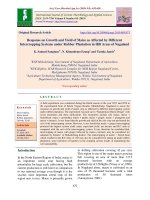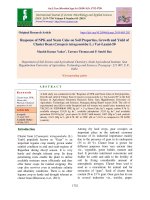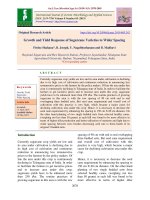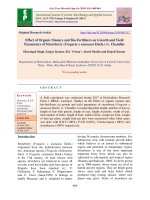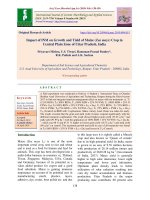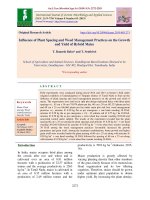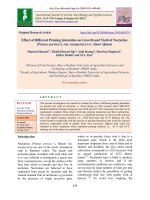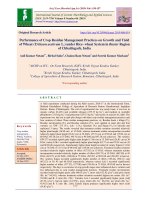Comparative study on growth and yield performance of pink oyster mushroom on different substrates
Bạn đang xem bản rút gọn của tài liệu. Xem và tải ngay bản đầy đủ của tài liệu tại đây (137.29 KB, 5 trang )
Int.J.Curr.Microbiol.App.Sci (2018) 7(7): 1981-1985
International Journal of Current Microbiology and Applied Sciences
ISSN: 2319-7706 Volume 7 Number 07 (2018)
Journal homepage:
Original Research Article
/>
Comparative Study on Growth and Yield Performance of Pink Oyster
Mushroom on Different Substrates
Tarun K. Mandaviya*, Ashok B. Brahmbhatt and Rameela I. Chaudhari
Department of Plant Pathology, B. A. College of Agriculture, Anand Agricultural University,
Anand-388110, Gujarat (India)
*Corresponding author
ABSTRACT
Keywords
Pink oyster,
Substrates, Fruiting
body, Stipe, Yield
Article Info
Accepted:
15 June 2018
Available Online:
10 July 2018
Five substrates viz., wheat straw, paddy straw, sorghum straw, maize straw, sugarcane
bagasse and banana pseudo stem were evaluated for production of pink oyster mushroom.
Four parameter related to growth viz., No. of fruiting body, diameter of cap, length and
thickness of stipe was measured. The results revealed that the highest number of fruiting
body was found in wheat straw (31.00) followed by paddy straw (27.00). The stipe length
of mushroom on different substrates ranged from 2.34 to 3.08 cm. The highest stipe length
was observed in wheat straw (3.08 cm) whereas the lowest was observed in sugarcane
bagasse (2.34 cm). Diameter of cap was also varied within substrates. The highest
diameter of cap was recorded in wheat straw (9.90 cm) which was at par with paddy straw
(9.70 cm). The highest thickness of stipe was found in sugarcane bagasse (6.53 cm) which
was at par with wheat straw (6.21 cm). Different types of substrates significantly
influenced the yield of mushroom. The highest yield obtained from wheat straw (213.20
g/kg) was superior among all substrates.
Introduction
India is the second largest populous country in
the world. Increasing in population creates an
alarming situation in food problem in India.
Malnutrition in terms of protein deficiency is
one of the major factors responsible for high
mortality and morbidity in this country and
other developing countries of the world. Due
to population explosion the problem of protein
hunger will become more and more acute.
Animal protein is beyond the reach of low
income group which forms a large proportion
of our population. Mushrooms, yeasts and
algal foods are frequently mentioned as
alternative sources of protein. Out of these,
mushrooms are the most preferred. In the
present
circumstances,
popularizing
mushroom as part and parcel of everyday food
is a need of an hour. Mushroom cultivation
has developed into a profitable industry in
many countries of the world. Mushrooms offer
vast rural employment potential. Mushrooms
cultivation involves various technologies. In
the instances where limited capital is
available, methods that require simple
equipments can be used. Most of these low
cost methods, suitable for rural projects, are
1981
Int.J.Curr.Microbiol.App.Sci (2018) 7(7): 1981-1985
labour-intensive and can provide employment
both in semi-urban and rural areas. India is
blessed with varied agro climate, abundance
of agricultural wastes and man-power making
it most suitable for the cultivation of all the
types of temperate, tropical and sub-tropical
mushrooms. It is estimated that about 355
million tones of agricultural waste are left out
for burning and incorporating in the soil in
manure form. If 1% of it is utilized to produce
mushrooms, India will be a major mushroom
producing country.
Under such circumstances, the present
investigation has been undertaken to find out
best substrates for growth and yield of pink
oyster mushroom. In the recent times, the
cultivation of Pleurotus sp. had excelled next
to Agaricusbisporus (Lange) Sıng. throughout
the world in terms of yield and production
(Erkel, 1992; Chang et al., 1991). These
studies mainly concentrated on the cultivation
on agricultural wastes. Almost, all the
available, lignocellulosic substances are likely
to be used as substrate for Pleurotus sp.
Cultivation with slight variation in the range
and combination of the substrates in different
parts of world based on their availability in
abundant and being cheaper in the respective
region (Royse, 1985; Schmidt, 1986). Most of
these studies focused on the higher yield and
quality of fruiting bodies of Pleurotussp. with
respect to cultivation times. The present study
deals with the cultivation of pink oyster on
some common and abundantly available waste
available for conversion in food which
otherwise is left for natural degradation. The
cultivation of edible mushrooms offers one of
the most feasible and economic method for the
bioconversion of agro-lignocellulosic wastes
(Bano et al., 1993; Cohen et al., 2002). The
technology can also limit air pollution
associated with burning agriculture wastes as
well as to decrease environmental pollution
due to unutilized agricultural wastes. The
results of the various experiments pertaining
to the present investigations are discussed in
this paper.
Materials and Methods
All the mushroom growing processes were
carried out in the Department of Plant
Pathology, B. A. College of Agriculture,
Anand Agricultural University, Anand.
Culture and cultivation
The pure culture of pink oyster mushroom was
obtained from Indian Institute of Horticultural
Research, Bengaluru (Karnataka) and the
culture was maintained in PDA during the
course of investigation.
Spawn preparation
Different types of grains were used for
preparation of spawn viz., wheat, sorghum and
maize grains. For the preparation of spawn,
grains were boiled in water for 20 min. and
allowed to remain soaked in the hot water for
about 20 minutes. Water drained off over a
wire netting. On the same day, gypsum @
1.32 g/100g and lime @ 2.5 g/100g on dry
weight basis of grains were added and
thoroughly mixed in boiled grain after
cooling.
The treated grains were filled into glass bottles
and autoclaved. Bottles filled with treated
grains were sterilized in autoclave at 121.1°C
with 15 kg/cm2 for 2 hrs. The sterilized bottles
were immediately transferred to isolation
chamber and allowed to cool down over night.
Next day, the bottles were inoculated with
pure culture of mushroom. The inoculated
bottles were incubated at 27 ± 1°C
temperatures. The mycelial growth was
observed up to 15 to 20 days after inoculation.
Mother spawn bottles were kept in BOD
incubator at 27 ± 2°C for further use.
1982
Int.J.Curr.Microbiol.App.Sci (2018) 7(7): 1981-1985
Different substrates viz., paddy straw, wheat
straw, maize straw, sugarcane bagasse and
sorghum straw were collected from the
various localities of Anand and campus of
AAU.
of stipe and thickness of stipe of the pink
oyster mushroom cultivated on different
substrates. The results presented in Table 1
indicated that among all substrates, wheat
straw was found to be the most suitable
substrate for pink oyster mushroom as
compared to other substrates.
Substrates pre-treatment
Number of fruiting body
The chopped substrates were soaked in water
to the extent that it contained 68 to 70 per cent
moisture. The soaked substrates were
chemically treated with bavistin 50% WP
@10 g/10 liters water and 40% of
formaldehyde solution (13.50 ml/10 liters of
water) for a period of 24 hours. Treated
substrates were put on a sieve for one hour for
the removal of excess solution.
Number of fruiting body were found highest
in wheat straw (31.00) followed by paddy
(27.00). Number of fruiting body in maize
straw (21.00) and sorghum straw (19.00) was
statistically at par with each other. Lowest
number of fruiting body was observed in
sugarcane bagasse (11.00). This result was
also confirmed with results of Mondal et al.,
(2010) who reported that the number of
effective fruiting body ranged from 8.5 to
37.25.
Collection of different substrates
Spawning
After squeezing of substrates they were filled
in layer in autoclavable polythene bags (5
bags, 60 x 30 cm, and 80 gauge). Layer
spawning were done @ 2 per cent weight of
substrates. Bags were tied with strings. Small
holes were made in bags for gaseous exchange
and better aeration and were incubated in
BOD incubator at 25 ± 1°C temperatures with
75 to 85 per cent relative humidity.
Harvesting and preservation of mushroom
The mature fruits were harvested before its
margin started to fold inwards. The yield of
mushroom was observed on different
substrates. The harvested mushrooms were
dried directly in sunlight. The dried
mushrooms were stored in air tight sealed
polythene bags (60 x 30 cm, and 80 gauge.) in
dry and cool place.
Results and Discussion
Stipe length
The stipe length of mushroom on different
substrates ranged from 2.34 to 3.08 cm. The
highest stipe length was observed in wheat
straw (3.08 cm) which was at par with paddy
straw (3.00 cm). Lowest stipe length was
observed in sugarcane bagasse (2.34 cm).
Similar results were obtained by Kharadi
(2007) who reported that the stipe length of
milky mushroom on different substrates
ranged from 2.17 to 3.20 cm. The highest stipe
length was observed in wheat straw (3.20 cm)
followed by paddy straw (2.20 cm) which was
at par with maize stalk (2.17 cm).The results
are similar to that of Lalani (2005) who
reported that the stipe length of mushroom on
different substrates ranged from 2.16 to 3.22
cm. The highest stipe length was observed in
paddy straw (3.22cm) which was at par with
cotton stalks (3.18cm) followed by sugarcane
bagasse (2.38cm) which was at par with wheat
straw (2.26cm) and maize straw (2.16cm).
In the present study, results reveal the yield,
No. of fruiting body, diameter of cap, length
1983
Int.J.Curr.Microbiol.App.Sci (2018) 7(7): 1981-1985
Diameter of cap
Diameter of cap also varied within substrates.
The highest diameter of cap were recorded in
wheat straw (9.90 cm) which was statistically
at par with paddy straw (9.70 cm). Lowest
diameter of cap was found in sugarcane
bagasse (7.21 cm). The results are in
agreement with report of Mondal et al.,
(2010).
Thickness of stipe
Thickness of stipe is also an important
parameter with respect to yield. The highest
thickness of stipe was found in sugarcane
bagasse (6.53 cm) which was statistically at
par with wheat straw (6.21 cm). Lowest
thickness of stipe was found in maize straw
(5.04 cm). Our finding is supported by Khan
and Ali (1982) who reported that oyster
mushrooms could be grown on most of the
agricultural wastes of which sugarcane
bagasse proved the best substrate for
sporophore production.
Yield
Different types of substrates influenced the
yield of mushroom significantly. The highest
yield was obtained from wheat straw (213.20
g/kg) which was superior among all
substrates. Paddy straw gave second highest
yield (161 g/kg) which was at par with maize
straw (141 g/kg). Lowest yield was obtained
from sugarcane bagasse (101.60 g/kg).
Table.1 Effects of different substrates on growth of mushroom
Sr.
No.
1.
2.
3.
4.
5.
Substrates
Wheat straw
Paddy straw
Maize straw
Sorghum straw
Sugarcane bagasse
S Em ±
CD @ 5%
CV %
No. of
fruiting
body
31
27
21
19
11
1.03
3.03
10.44
Length of
stipe (cm)
3.08
3.00
2.83
2.52
2.34
0.05
0.14
3.39
The result of the present experiment are is
agreement with the findings of Kumari and
Achal (2008) who found that the highest yield
of Pleurotus ostreatus was recorded on wheat
straw followed by the combination of paddy
and wheat straw. Similar results were also
found by Patil and Jadhav (1991) who tested
different fourteen substrates separately and in
three combinations of selected substrates for
productivity. Among fourteen substrates,
cotton stalk produced significantly higher
yield followed by wheat and paddy straw.
Sugar cane trash recorded the lowest yield.
Diameter
of cap
(cm)
9.90
9.70
9.04
8.66
7.21
0.13
0.37
3.15
Thickness
of stipe
(cm)
6.21
5.99
5.04
5.43
6.53
0.08
0.25
3.23
Yield
(g/kg
substrates)
213.20
161.00
141.00
140.00
101.60
7.55
22.27
11.15
Acknowledgement
The author is grateful to Indian Institute of
Horticultural
Research,
Bengaluru
(Karnataka) for providing pure culture and
Department of Plant Pathology, B. A. College
of
Agriculture,
Anand
Agricultural
University, Anandfor providing necessary
facilities.
References
Erkel, I. 1992. Effects of Different Growing
1984
Int.J.Curr.Microbiol.App.Sci (2018) 7(7): 1981-1985
Medium on yield of Pleurotus
ostreatus and Pleurotus florida
Cultivation, Fourth Congress of Edible
Mushroom of Turkey, Vol. I, pp:8.
Cohen, R.,Persky, L. andHadar, Y. 2002.
Biotechnological applications and
potential
of
wood
degrading
mushrooms of the genus Pleurotus.
Applied
Microbiology
and
Biotechnology. 58: 582–594.
Chang, S. T. and Miles P. G. 1991. Recent
trends in World Production of
Cultivated Edible Mushrooms. Mushr.
Jour.503: 15-18.
Bano, Z.,Shasirekha, M. N. and Rajarathnam,
S. 1993. Improvement of the
bioconversion and biotransformation
efficiencies of the oyster mushroom
(Pleurotus
sajor-caju)
by
supplementation of its rice straw with
oil seed cakes. Enzyme and Microbial
Technology. 15: 985–989.
Royse, D. J. 1985. Effects of spawn run time
and substrate nutrition on yield and
size
of
the
shiitake
mushroom.Mycologia.75(5): 756-762.
Schmidt, O. 1986. Experiments with
mushroom cultivation on wood waste.
Plant Research and Development 24:
pp: 85-92.
Mondal, S. R., Rehana, M. J., Noman, M. S.
and
Adhikary,
S.
K.
2010.
Comparative study on growth and
yield
performance
of
oyster
mushroom (Pleurotus florida) on
different substrates. J. Bangladesh
Agril. Univ. 8 (2): 213–220.
Lalani, B. H. 2005. Studies on spawn
production, biochemical constituents
and utilization of agricultural waste
material
for
production
of
Pleurotusflorida in Central Gujarat,
(Master thesis, Anand Agricultural
University, Anand, Gujarat).
Kharadi, K. G. 2007. Studies on spawn
production, biochemical constituents
and utilization of agricultural waste
material for production of Calocybe
indica in Central Gujarat, (Master
thesis, Anand Agricultural University,
Anand, Gujarat).
Khan, S. and Ali, M. 1982. Cultivation of
oyster mushroom Pleurotus on ball
locules. Mushroom Sci. 11 (1): 691695.
Kumari, D. and Achal, V. 2008. Effect of
different substrates on the production
and
non-enzymatic
antioxidant
activity of Pleurotus ostreatus(Oyster
mushroom). J. Life Sci. 5 (3): 73-76.
Patil, B. D. andJadhav, S. W. 1991. Yield
performance of P. sajorcaju on
various substrate. Proc of the Nath.
Symp on Indian mush. pp: 84-86.
How to cite this article:
Tarun K. Mandaviya, Ashok B. Brahmbhatt and Rameela I. Chaudhari. 2018. Comparative
Study on Growth and Yield Performance of Pink Oyster Mushroom on Different Substrates.
Int.J.Curr.Microbiol.App.Sci. 7(07): 1981-1985. doi: />
1985

